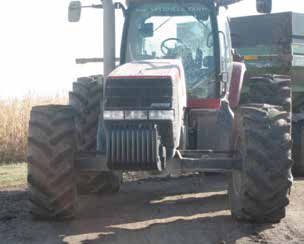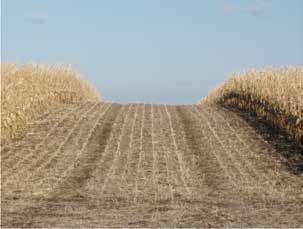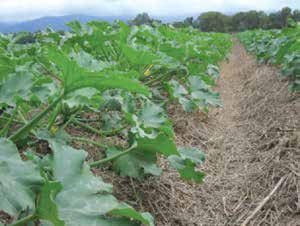chAPter 15 Preventing and lessening CoMPaCtion
through tillage loosens the soil, which may be beneficial
these materials relative to soil compaction may be very
if the soil has been heavily trafficked. This would be the
favorable, but in many cases the application procedure
case with a sod crop that was actively managed for for-
itself is a major cause of compaction. Livestock-based
age production, sometimes with traffic under relatively
farms in humid regions usually apply manure using
wet conditions. Incorporation through tillage also
heavy spreaders (often with poor load distribution) on
encourages rapid nitrogen mineralization. Compared
wet or marginally dry soils, resulting in severe compac-
to plowing down a sod crop, cutting and mulching in a
tion of both the surface layer and the subsoil. In general,
no-till or zone-till system reduces nutrient availability
the addition of organic materials should be done with
and does not loosen the soil. But a heavy protective mat
care to obtain the biological and chemical benefits, while
at the soil surface provides some weed control and bet-
not aggravating compaction problems.
ter water infiltration and retention. Some farmers have
Controlled traffic and permanent beds. One
been successful with cut-and-mulch systems involving
of the most promising practices for reducing soil com-
aggressive, tall cover or rotation crops, such as rye and
paction is the use of controlled traffic lanes in which all
sudan grass.
field operations are limited to the same lanes, thereby
Addition of organic materials. Regular addi-
preventing compaction in all other areas. The primary
tions of animal manure, compost, or sewage sludge
benefit of controlled traffic is the lack of compaction
benefit the surface soil layer to which these materials
for most of the field at the expense of limited areas
are applied by providing a source of organic matter and
that receive all the compaction. Because the degree of
glues for aggregation. The long-term benefits of applying
soil compaction doesn’t necessarily worsen with each
equipment pass (most of the compaction occurs with the
heaviest loading and does not greatly increase beyond
it), damage in the traffic lanes is not much more severe
than that occurring on the whole field in a system with
uncontrolled traffic. Controlled traffic lanes may actually
have an advantage in that the consolidated soil is able to
bear greater loads, thereby better facilitating field traffic.
Compaction also can be reduced significantly by maxi-
mizing traffic of farm trucks along the field boundaries
and using planned access roads, rather than allowing
them to randomly travel over the field.
Controlled traffic systems require adjustment of field
equipment to ensure that all wheels travel in the same
lanes; they also require some discipline from equip-
ment operators. For example, planter and combine
widths need to be compatible (although not necessarily
the same), and wheel spacing may need to be expanded
(figure 15.10). A controlled traffic system is most easily
adopted with row crops in zone, ridge, or no-till systems
Figure 15.9. A combination of deep alfalfa roots and shal ow, dense grass roots helps address compaction at different depths.
(not requiring full-field tillage; see chapter 16), because
169
Building SoilS for Better CropS: SuStainaBle Soil ManageMent









